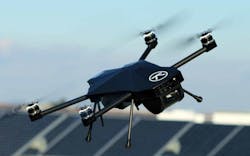When talking about future security technologies and threats, few topics stir the imagination as much as drone technology. According to the FAA’s 2016 20-year forecast, sales of small Unmanned Aircraft Systems (sUAS) – aka drones – are projected to double from 2.5 million units in 2016 to 4.8 million in 2017, and up to 7 million by 2020.
This technology is poised to impact security and surveillance in a big way. Where will the technology be helpful? How does the industry deal with the threats that the technology spawns? In today’s regulatory roll-back environment, will it take a tragic event to focus attention and crystallize effective counter-measures?
Mark Schreiber, President of Safeguards Consulting (www.safeguardsconsulting.com), has carefully followed the development of drone technology and its implications over the last three years. In terms of deploying them as part of a comprehensive security solution, he says he has “seen a definite spike in interest and investigation of the technology in emerging operations: however, people are still wary and learning about possible unintended consequences.”
According to Cary Savas, VP of Marketing for Nightingale Security (www.nightingalesecurity.com), a prominent exhibitor at ISC West, the common application scenario for his customer base is a large parcel of property – usually not be defended by people or technology – that are often in less-accessible areas, such as chemical plants, mining sites and nuclear power plants. The presence of armed intruders in these areas is often a worry.
Nightingale’s Robotic Aerial Security product enables the transmission of live video via integrations with several VMS platforms. Additionally, Robotic Aerial Security as a Service is a means to diminish initial CapEx. Nightingale projects growing demand for its products for perimeter and remote area surveillance and for remote guard tours.
Anti-Drone Takes Off
The threats associated with drones and potential counters to those pose a dilemma. “Drone technology is taking what has essentially been a two-dimensional problem into a third dimension,” Savas says.
Video surveillance, intrusion detection and access control systems were not necessarily designed for the possibility of something flying over them. Illicit information gathering, smuggling of contraband, removal of sensitive information in cooperation with an insider, or even dropping of ordnance or weapons discharge are all concerns.
The wars in the Middle East have clearly shown the potential. “It’s worth noting that the bomb-dropping drones are just a small part of how ISIS uses the cheap, unmanned flying machines,” according to an article in Popular Science magazine. “Other applications include scouts and explosive decoys, as well as one-use weapons – it is a growing field of research and development among many violent, non-state actors and insurgent groups.”
“Drone counter-measures are coming to market in a pretty strong way,” Schreiber says. “Counter-measures from the DoD environment are being miniaturized and starting to transition into the commercial environment.”
I reviewed a number of vendor offerings in the anti-drone space and found a number of different approaches. Note that these may not be approved for commercial use without permission.
Neutralize the operator: LRAD from ANTIDRONE (www.anti-drone.eu) purports to “project a controlled beam of noise on the drone operator in order to disorientate him and distract him from controlling a UAV, which at the same time provides the security personnel with the time necessary to catch the culprit.”
Train birds to attack: Why not just turn loose a trained bird of prey on the invading drone? Guard from Above (www.guardfromabove.com) does just that. Check it out: http://youtu.be/Vd00zh4NGcc.
Shoot them down: Ferromagnetic rounds can be fired to disable a drone’s electronics, such as the product by Snake River Shooting Products (www.dronemunition.com); or, go full-bore with anti-missile laser technology such as the Compact Laser Weapon System from Boeing.
Go Spiderman on them: Fire a 12 gauge or 40MM shell with nets inside from Advanced Ballistic Concepts (www.mibullet.com); or take them down with a 22-pound “Net cannon” from OpenWorks Engineering (www.openworksengineering.com) that shoots a net up to 100 yards. Also see Drone Defence’s (www.dronedefence.co.uk) Net Gun X1, which can be specified with two different types of capture nets.
Drop nets from other drones or aircraft: Theiss UAV Solutions’ (www.theissuav.com) EXCIPIO fires a net from a neighboring aircraft. Once the target has been “netted,” it can either release the net with the neutralized target ensnared (with a small parachute to slow its descent), or keep the net tethered to the aircraft for forced relocation.
Jam them: An anti-drone jamming rifle has been demonstrated by the Dubai Civil Aviation Authority (DCAA) and the Sanad Academy. Similarly, DroneShield’s (www.droneshield.com) system uses acoustic monitoring and a signature database to jam targets up to 2 km. Other fixed or mobile jamming systems (control, GPS, video) are offered by MCTech (www.mctech-jammers.com) to intercept drones up to 2.5 kilometers away and Drone Defence’s Dynopsis works up to 3 km.
Hijack them: Department 13’s (www.department13.com) MESMER Counter Drone Software platform for detection and mitigation of radio controlled devices includes adapting to the protocol used to control a drone and inserting its own messages.
Integrated solutions
“The most effective solutions are going to involve an integration of technologies employing both detection and interference,” Schreiber says.
- SENSOFUSION’s (www.sensofusion.com) AIRFENCE System is an example – employing RF, GPS and other technologies to automatically detect, locate, track and eventually take over UAV controls.
- ANTIDRONE offers a range of components for detection, including surveillance radars, RF detectors, infrared surveillance and acoustic sensors, and then deploys automatic jamming.
- Battelle (www.battelle.com) has developed the Drone Defender, an integration of anti-drone technologies including radars, cameras, jammers and interceptors.
- Blighter Surveillance Systems (www.blighter.com), Dedrone (www.dedrone.com), DeTect (www.detect-inc.com) and Liteye Systems (www.liteye.com) also offer integrated systems.
Schreiber notes that using these technologies comes with the caveat of obeying policy, procedure and local laws. Be sure to read the fine print as well, such as this disclaimer from Battelle: “This device has not been authorized as required by the rules of the Federal Communications Commission. This device is not, and may not be, offered for sale or lease, or sold or leased in the United States, other than to the United States government and its agencies, until authorization is obtained. Under current law, the DroneDefender may be used in the United States only by authorized employees of the Federal government and its agencies, and use by others may be illegal.”
Ray Coulombe is Founder and Managing Director of SecuritySpecifiers and RepsForSecurity.com. Reach him at [email protected], through LinkedIn at www.linkedin.com/in/raycoulombe or follow him on Twitter: @RayCoulombe.
About the Author
Ray Coulombe
Ray Coulombe is founder of SecuritySpecifiers.com, the industry’s largest searchable database of specifiers in the physical security and ITS markets. He is also Principal Consultant for Gilwell Technology Services. He can be reached at [email protected] or through LinkedIn.

